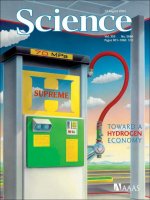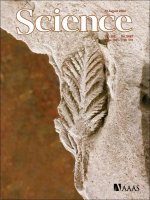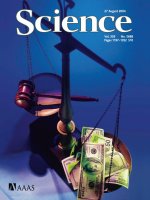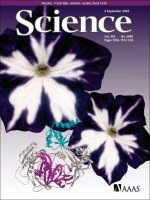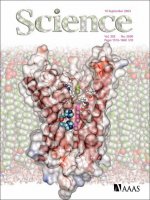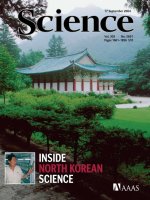- Trang chủ >>
- Khoa Học Tự Nhiên >>
- Vật lý
Tạp chí khoa học số 2005-11-18
Bạn đang xem bản rút gọn của tài liệu. Xem và tải ngay bản đầy đủ của tài liệu tại đây (15.11 MB, 160 trang )
18 November 2005
Vol. 310 No. 5751
Pages 1073–1228 $10
TeAM
YYePG
Digitally signed by TeAM YYePG
DN: cn=TeAM YYePG, c=US,
o=TeAM YYePG, ou=TeAM
YYePG, email=
Reason: I attest to the accuracy
and integrity of this document
Date: 2005.11.19 16:36:59 +08'00'
Need More Information? Give Us A Call:
Stratagene USA and Canada
Order: (800) 424-5444 x3
Technical Services: (800) 894-1304 x2
Stratagene Japan K.K.
Order: 03-5159-2060
Technical Services: 03-5159-2070
#/2.+(+%#6+10
%' $+1.1); %.10+0) /+%41#44#;5
07%.'+%#%+&
#0#.;5+5
2416'+0(70%6+10
#0#.;5
+5
37#06+6#6+8'
2%4
51(69#4'
51.76+105
YYYUVTCVCIGPGEQO
Stratagene Europe
Order: 00800-7000-7000
Technical Services: 00800-7400-7400
If it’s in there, you’ll find it.
StrataScript
®
QPCR cDNA Synthesis Kit generates cDNA from even
the smallest amounts of RNA quickly and reliably.
• Maximum RNA sensitivity
• Excellent linearity
• Most reliable two-step QRT-PCR data
*
Purchase of this PCR-related product does not convey any rights under the foreign
counterparts of the PCR patents owned by Roche Molecular Systems. A license to
use the PCR process, where such process is covered by patents, accompanies the
purchase of certain reagents from Stratagene when used in conjunction with an
Authorized Thermal Cycler.
Ask Us About These Great Products:
StrataScript
®
QPCR cDNA Synthesis Kit 50 rxn 600554
Our StrataScript
®
Quantitative PCR (QPCR) cDNA Synthesis Kit
*
delivers
maximum RNA sensitivity and dynamic range down to sub-picogram RNA
levels. Achieve high efficiency reverse transcription and better R Squared
values in our new buffer system and master mix format, which greatly
reduces sample transfer errors known to hamper results. Each batch is
QPCR-qualified to ensure you produce the most reliable two-step
quantitative reverse-transcriptase PCR (QRT-PCR) data.
GE Healthcare
To 100,000 scientists worldwide, the name ÄKTA
™
has
always meant outstanding protein purification, and now it’s
brought to you by GE Healthcare. With the ability to purify
virtually 100% of all biomolecules, the ÄKTAdesign
™
platform
can handle the toughest of challenges. Whatever the scale,
from laboratory, to process development and manufacturing,
there’s an ÄKTAdesign system to meet every need. All systems
in the ÄKTAdesign family work with the intelligent UNICORN
™
software, which makes it easy to control every stage of your
purification processes. Accurate, reproducible results just take
a little pure imagination.
Visit www.amershambiosciences.com/aktadesign
Why do 100,000 scientists trust
GE Healthcare for all their
protein purification needs?
Here’s Ä clue.
© 2005 General Electric Company - All rights reserved.
Amersham Biosciences AB, a General Electric company
going to market as GE Healthcare.
GE15-05
www.sciencemag.org SCIENCE VOL 310 18 NOVEMBER 2005
1077
DEPARTMENTS
1083 SCIENCE ONLINE
1085 THIS WEEK IN SCIENCE
1089 EDITORIAL by Jim Austin and Donald Kennedy
Not Just Jobs: ScienceCareers.org
1091 E
DITORS’CHOICE
1096 CONTACT SCIENCE
1099 NETWATCH
1199 NEW PRODUCTS
1200 SCIENCE CAREERS
NEWS OF THE WEEK
1100 STEM CELLS
Collaborators Split Over
Ethics Allegations
1101 U.S. H
IGHER EDUCATION
Professor Sues University Over Building He Is
Funding
1101 P
OLITICS
Antiterror Law Intrusive,
U.K. Academic Groups Warn
1102 A
FRICAN SCIENCE
A Move to Revamp Elite Institutions
Across the Continent
1103 I
NFLUENZA
Meeting Seeks Global Consensus,
Highlights Global Disparities
1103 S
CIENCESCOPE
1104 NEUROSCIENCE
Neuroscientists Welcome Dalai Lama With
Mostly Open Arms
1105 T
EACHING EVOLUTION
Antievolutionists Win One in Kansas,
Lose Eight Seats in Dover
NEWS FOCUS
1106 ENERGY SUPPLIES
Bumpy Road Ahead for World’s Oil
If Not Cheap Oil
1109 MEETING
Developmental Basis of Evolution
Hummingbirds Keep Plant Speciation Humming Along
Development Out of Sync
1110 PROFILE:EDWARD AMES
Uncovering the Hidden Paths of Maine’s
Threatened Cod
1112 A
VIAN INFLUENZA
Pandemic Skeptics Warn Against Crying Wolf
1114 R
ANDOM SAMPLES
LETTERS
1117 New Directions in Plastic Debris R. Thompson et al.
Preparing for the Worst-Case Scenario P. H.A.Chung.
Response I. M.Longini Jr. and M. E. Halloran.
Collecting Samples Before and After V. Mai et al.
Response P. B. Eckburg et al.
1119 Corrections and Clarifications
BOOKS ET AL.
1120 NEUROSCIENCE
The War of the Soups and the Sparks
The Discovery of Neurotransmitters and the
Dispute over How Nerves Communicate
E. S.Valenstein, reviewed by A. Carlsson
1121 PHILOSOPHY OF SCIENCE
Molecular Models of Life
Philosophical Papers on Molecular Biology
S. Sarkar, reviewed by M. A. Goldman
POLICY FORUM
1122 EPIDEMIOLOGY
DNA Identifications After the 9/11 World Trade
Center Attack
L. G. Biesecker et al.
Contents continued
1125 &
1174
1106
SPECIAL ISSUE
MATERIALS AND BIOLOGY
Confocal micrograph of an artificial compound eye produced by biologically inspired
optical system synthesis. Each microlens is individually self-aligned with an artificial
cone and a waveguide. See page 1148. [Image: K. Jeong]
INTRODUCTION
1131 Design for Living
NEWS
1132 Nanotechnology Takes Aim at Cancer
REVIEWS
1135 Exploring and Engineering the Cell Surface Interface
M. M. Stevens and J. H. George
1139 Tissue Cells Feel and Respond to the Stiffness of
Their Substrate
D. E. Discher, P. Janmey,Y.Wang
1144 Rigid Biological Systems as Models for Synthetic Composites
G. Mayer
1148 Inspirations from Biological Optics for Advanced
Photonic Systems
L. P. Lee and R. Szema
Related Brevia page 1151
Volume 310
18 November 2005
Number 5751
For related online content
see page 1083 or go to
www.sciencemag.org/sciext/materials/
Systems Biology — DNA Amplification
Hit your hot-start PCR target first time —
the best just got faster!
WWW. QIAGEN. COM
Gel-tracking dyes in HotStarTaq
Plus
PCR buffer enable immediategel
loading
Higher PCR specificity with QIAGEN
(Q
I
,Q
II
) than withenzymes from
Supplier I, A
II
, or R
New
New hot-start enzymes for high PCR specificity and sensitivity with minimaloptimization!
Specificity, sensitivity,and easy handling,combined with minimaloptimization are the
key reasons why researchers trust QIAGEN
®
enzymes. Now, withour 2 new hot-start PCR
enzymes, you get successful results faster and more conveniently thanever before!
HotStarTaq
®
Plus
DNA Polymerase
■ Fast 5-minuteenzyme activation time combined with unrivaled performance
■ Choiceoforiginalor ready-to-load PCR buffer for added convenience
HotStar HiFidelity Polymerase Kit
■ Increased sensitivity and reliability
■ New high-fidelity enzyme with10-fold higher fidelity than
Taq
DNA Polymerase
QIAGEN
®
,HotStarTaq
®
(QIAGEN Group). PurchaseofQIAGEN products for PCR containing
Taq
DNA Polymerase,HotStarTaq DNA Polymerase,HotStarTaq
Plus
DNA
Polymerase, or HotStar HiFidelity DNA Polymeraseis accompanied by a limited license to use them in the polymerase chain reaction (PCR)process for research and
development activities in
conjunction with a thermal cycler whose usein the automated performanceof the PCR process is covered by the up-front licensefee, either by
payment to Applied Biosystems or as purc
hased, i.e. an authorized thermal cycler. The PCR process is covered by the fo reign counterparts of U.S. Patents Nos.4,683,202
and 4,683,195 owned by F. Hoffmann-La Roche Ltd. AppDHST1005S1WW 09/2005 © 2005 QIAGEN, all rights reserved.
For fast and successful PCR results — visit www.qiagen.com/goto/PCR .
MQ
I
Q
II
IA
II
R
www.sciencemag.org SCIENCE VOL 310 18 NOVEMBER 2005
1079
PERSPECTIVES
1124 CELL BIOLOGY
Twists in the Tale of the Aging Yeast J. Rine related Report page 1193
1125 GEOCHEMISTRY
A Stranger in Paradise P. F. McMillan related Report page 1174
1126 PALEONTOLOGY
Dinosaurs Dined on Grass D. R. Piperno and H D. Sues related Report page 1177
1128 GENETICS
Two Genes Link Two Distinct Psychoses A. Sawa and S. H. Snyder related Report page 1187
SCIENCE EXPRESS www.sciencexpress.org
GEOCHEMISTRY: Heterogeneous Hadean Hafnium: Evidence of Continental Crust
at 4.4 to 4.5 Ga
T. M. Harrison, J. Blichert-Toft,W. Müller, F. Albarede, P. Holden, S. J.Mojzsis
Isotopic data from more than 100 of Earth’s oldest preserved minerals imply that Earth had significant
continental crust by 4.3 and perhaps as early as 4.5 billion years ago.
MEDICINE: Prostaglandin E
2
Promotes Colon Cancer Cell Growth Through a Novel
G
s
-Axin-β-Catenin Signaling Axis
M. D. Castellone, H. Teramoto, B. O.Williams, K. M. Druey, J. S. Gutkind
A factor that causes inflammation enhances colon cancer growth through a newly described signaling pathway.
NEUROSCIENCE: Glial Membranes at the Node of Ranvier Prevent Neurite Outgrowth
J. K. Huang, G. R. Phillips, A. D. Roth, L. Pedraza,W. Shan,W. Belkaid, S. Mi,
A. Fex-Svenningsen, L. Florens, J. R.Yates III, D. R. Colman
Sections of neuronal axons that are devoid of myelin wrapping are prevented from sprouting inappropriately by
adjacent glia membranes containing an inhibitory protein.
BIOCHEMISTRY: Evidence for Macromolecular Protein Rings in the Absence of Bulk Water
B. T. Ruotolo, K. Giles, I. Campuzano, A. M. Sandercock, R. H. Bateman, C. V. Robinson
Protein-protein assemblies and protein-ligand complexes retain their overall structures during mass spectroscopy,
suggesting a new tool for structural determinations.
BREVIA
1151 BIOMATERIALS: Directionally Controlled Fluorescence Emission in Butterflies
P.Vukusic and I. Hooper
Butterfly scales contain two-dimensional photonic crystals with a direct reflector, producing an intense fluorescence
similar to that of light-emitting diodes. related Materials and Biology section page 1131
RESEARCH ARTICLES
1152 CELL BIOLOGY: Logic of the Yeast Metabolic Cycle: Temporal Compartmentalization of Cellular
Processes
B. P.Tu, A. Kudlicki, M. Rowicka, S. L. McKnight
Two protein components of the transcriptional feedback loops that form the circadian clock move into the nucleus
independently, invalidating a central assumption about the clock’s timekeeping mechanism.
1159 STRUCTURAL BIOLOGY: Structure of the Quaternary Complex of Interleukin-2 with Its α, β, and γ
c
Receptors
X. Wang, M. Rickert, K. C. Garcia
A hormone activates immune cells by sequentially recruiting two specific receptors and then a common third
receptor, forming a high-affinity signaling complex.
REPORTS
1164 PHYSICS: Thermodynamics of an Incommensurate Quantum Crystal
P.W.Anderson, W. F. Brinkman, D.A. Huse
A thermodynamic model explains that supersolid
4
He—a solid that flows as a superfluid—is a crystal in which the
number of lattice sites mismatches the number of atoms.
1166 CHEMISTRY: Porous, Crystalline, Covalent Organic Frameworks
A. P. Côté, A. I. Benin, N.W. Ockwig, M. O’Keeffe, A. J. Matzger, O. M.Yaghi
Condensation of organic boron compounds produces useful materials containing large pores that are stable to
high temperatures and do not require linking metal atoms.
1166
Contents continued
1159
Credits: M. Rickert & K. C. Garcia
Not only does SciFinder provide access to more proteins and nucleic acids than any
publicly available source, but they’re a single click away from their referencing patents
and original research.
Coverage includes everything from the U.S. National Library of Medicine’s (NLM) MEDLINE
®
and
much more. In fact, SciFinder is the only single source of patents and journals worldwide.
Once you’ve found relevant literature, you can use SciFinder’s powerful refinement tools to focus on a
specific research area, for example: biological studies such as target organisms or diseases; expression
microarrays; or analytical studies such as immunoassays, fluorescence, or PCR analysis. From each reference,
you can link to the electronic full text of the original paper or patent, plus use citation tools to track how
the research has evolved and been applied.
Visualization tools help you understand results at a glance. You can categorize topics and substances,
identify relationships between areas of study, and see areas that haven’t been explored at all.
Comprehensive, intuitive, seamless—SciFinder directs you. It’s part of the process. To find out more, call
us at 1-800-753-4227 (North America) or 1-614-447-3700 (worldwide) or visit www.cas.org/SCIFINDER.
A division of the American Chemical Society. SciFinder is a registered trademark of the American Chemical
Society. “Part of the process” is a ser vice mark of the American Chemical Society.
It is.
Part of the process.
SM
What if moving from one particular
protein to the most relevant journal
and patent literature were as easy
as pushing a button?
www.sciencemag.org SCIENCE VOL 310 18 NOVEMBER 2005
1081
1171 APPLIED PHYSICS: Bright Infrared Emission from Electrically Induced Excitons in Carbon Nanotubes
J. Chen,V. Perebeinos, M. Freitag, J. Tsang, Q. Fu, J. Liu, Ph. Avouris
When paired electrons and holes generated in suspended nanotubes recombine,
they emit intense infrared radiation, with an efficiency greater than that of typical
light-emitting diodes.
1174 GEOCHEMISTRY: Retention of Xenon in Quartz and Earth’s Missing Xenon
C. Sanloup, B. C. Schmidt, E. M. Chamorro Perez, A. Jambon, E. Gregoryanz,
M. Mezouar
Experiments suggest that enough xenon can substitute for silicon in quartz (SiO
2
)
in the deep crust to explain a marked deficit of xenon in Earth’s atmosphere.
related Perspective page 1125
1177 PALEONTOLOGY: Dinosaur Coprolites and the Early Evolution of Grasses and Grazers
V. Prasad, C. A. E. Strömberg, H. Alimohammadian, A. Sahni
Silica particles from grass in fossil dung from Cretaceous sauropods suggest that grasses evolved earlier than
had been thought, providing food for dinosaurs and early mammals. related Perspective page 1126
1180 PLANT SCIENCE: Pre- and Postinvasion Defenses Both Contribute to Nonhost Resistance
in Arabidopsis
V. Lipka, J. Dittgen, P. Bednarek, R. Bhat, M.Wiermer, M. Stein, J. Landtag,W.Brandt, S. Rosahl,
D. Scheel, F.Llorente, A. Molina,J. Parker, S. Somerville, P.Schulze-Lefert
A robust defense system that protects plants from fungal invasion depends on both a cellular enzyme and
a signaling pathway that leads to death of infected cells.
1184 GENETICS: GTF2IRD1 in Craniofacial Development of Humans and Mice
M. Tassabehji, P. Hammond, A. Karmiloff-Smith, P. Thompson, S. S. Thorgeirsson, M. E. Durkin,
N. C. Popescu, T. Hutton, K. Metcalfe, A. Rucka, H. Stewart, A. P. Read, M. Maconochie, D. Donnai
Of the 28 genes deleted in the complex human disorder Williams-Beuren syndrome, one has been identified
as responsible for the facial abnormalities seen in patients.
1187 GENETICS: DISC1 and PDE4B Are Interacting Genetic Factors in Schizophrenia That Regulate
cAMP Signaling
J. K. Millar, B. S. Pickard, S. Mackie, R. James, S. Christie, S. R. Buchanan, M. P. Malloy, J. E. Chubb,
E. Huston, G. S. Baillie, P. A. Thomson, E.V. Hill, N. J. Brandon, J C. Rain, L. M. Camargo, P. J.Whiting,
M. D. Houslay, D. H. R. Blackwood,W.J. Muir, D. J. Porteous
Two genes associated with schizophrenia code for interacting proteins that modulate cyclic AMP metabolism,
suggesting that this signaling pathway may contribute to the disorder. related Perspective page 1128
1191 IMMUNOLOGY: Altered TCR Signaling from Geometrically Repatterned Immunological Synapses
K. D. Mossman, G. Campi, J. T. Groves, M. L. Dustin
Manipulating the position of the antigen receptor within the immune synapse shows that receptors near
the outside work best.
1193 CELL BIOLOGY: Regulation of Yeast Replicative Life Span by TOR and Sch9 in Response to Nutrients
M. Kaeberlein,R.W. Powers III, K. K. Steffen, E. A. Westman, D. Hu, N. Dang, E. O. Kerr, K.T. Kirkland,
S. Fields, B. K. Kennedy
A search of all yeast genes identifies two signaling enzymes belonging to a pathway that increases life span
when calories are restricted. related Perspective page 1124
1196 CELL BIOLOGY: Golgi Duplication in Trypanosoma brucei Requires Centrin2
C.Y. He, M. Pypaert, G. Warren
A bi-lobed structure within cells contains an organelle-replication protein, which is required for
duplication and faithful segregation of the Golgi complex to daughter cells.
SCIENCE (ISSN 0036-8075) is published weekly on Friday, except the last week in December, by the American Association for the Advancement of
Science, 1200 New York Avenue, NW, Washington, DC 20005. Periodicals Mail postage (publication No. 484460) paid at Washington, DC, and additional
mailing offices. Copyright © 2005 by the American Association for the Advancement of Science. The title SCIENCE is a registered trademark of the AAAS.
Domestic individual membership and subscription (51 issues): $135 ($74 allocated to subscription). Domestic institutional subscription (51 issues): $550;
Foreign postage extra: Mexico, Caribbean (surface mail) $55; other countries (air assist delivery) $85. First class, airmail, student, and emeritus rates on
request. Canadian rates with GST available upon request, GST #1254 88122. Publications Mail Agreement Number 1069624. Printed in the U.S.A.
Change of address: allow 4 weeks, giving old and new addresses and 8-digit account number. Postmaster: Send change of address to Science, P.O. Box 1811, Danbury, CT 06813–1811. Single copy sales: $10.00
per issue prepaid includes surface postage; bulk rates on request. Authorization to photocopy material for internal or personal use under circumstances not falling within the fair use provisions of the Copyright
Act is granted by AAAS to libraries and other users registered with the Copyright Clearance Center (CCC) Transactional Reporting Service, provided that $15.00 per article is paid directly to CCC, 222 Rosewood
Drive, Danvers, MA 01923. The identification code for Science is 0036-8075/83 $15.00. Science is indexed in the Reader’s Guide to Periodical Literature and in several specialized indexes.
Contents continued
REPORTS CONTINUED
1180
1128 &
1187
J.T.Baker
®
and Mallinckrodt
®
.
Two great brands. One unique source for chemicals.
Every day, thousands of laboratories around the globe put
their trust in chemicals from Mallinckrodt Baker. Our diverse
product line offers a match for virtually
any application you’re working on.
Plus, our chemicals deliver consistent
results…time after time.
For details about the
chemicals that are right
for your application, visit
www.mallbaker.com/lab
Mallinckrodt Baker.
We’ve been a hit with chemists for 130 years.
Quality
◆
Choice
◆
Value
J.T.Baker
®
is a trademark of Mallinckrodt Baker, Inc. Mallinckrodt
®
is a trademark of Mallinckrodt Baker, Inc.
©2005 Mallinckrodt Baker, Inc. All rights reserved.
1083
www.sciencemag.org SCIENCE VOL 310 18 NOVEMBER 2005
sciencenow www.sciencenow.org DAILY NEWS COVERAGE
Flying by Feel
Touch receptors on bats’ wings aid aerial pursuit of prey.
Charge of the Caterpillars
Climate change could cause an explosion in the insect’s numbers.
Driven to Create?
New study suggests genetic link between bipolar disorder and artistic tendencies.
ScienceCareers.org www.sciencecareers.org CAREER RESOURCES FOR SCIENTISTS
US: ScienceCareers.org—Your Science Career, in a Nutshell J. Austin
Science Magazine’s two career sites, Next Wave and ScienceCareers.org, are now one.
US: Tooling Up—Developing Resilience D. Jensen
Making it through graduate school, and beyond, requires a thick skin.
EUROPE: Using Math to Predict Physical Phenomenon A. Forde
Applied mathematician Snorre Christiansen aims to predict how black holes might collide.
EUROPE: Industry Insider—The European Steel Industry, a Phoenix Rising from the Ashes
A. Michels
The European steel industry is seeking young researchers to fill their research labs.
MISCINET: Clinton Junior College—Monitoring, Motivating, and Mentoring Students in STEM
C. Parks
Students are preparing for science and technology careers thanks to the Curriculum Institute
Partnership Award, sponsored by NASA.
science’s sage ke www.sageke.org SCIENCE OF AGING KNOWLEDGE ENVIRONMENT
related Materials and Biology Section page 1131
NEWS SYNTHESIS: Bionic Grandma R. J. Davenport
Engineered tissues might someday rejuvenate the elderly.
PERSPECTIVE: Immune Shaping and the Development of Alzheimer’s Disease Vaccines
H. J. Federoff and W. J. Bowers
The search is on for efficacious AD vaccines that do not promote dangerous brain inflammation.
NEWS FOCUS: A Switch in Time Saves Mind M. Leslie
Aging rats preserve their memory by adjusting their response to stimulation.
science’s stke www.stke.org SIGNAL TRANSDUCTION KNOWLEDGE ENVIRONMENT
CONNECTIONS MAP: Angiotensin II– Stimulated Signaling Through G Proteins and
β
-Arrestin
S. K. Shenoy and R. J. Lefkowitz
Arrestins and G proteins activate cooperative and independent signaling pathways in HEK-293 cells.
ST ON THE WEB
Explore protein phosphorylation using PhosphoSite and Scansite in the Protein Databases section.
Activating cytosolic
MAPK with
β
-arrestin.
Rejuvenating tissues.
The new ScienceCareers.org
GrantsNet
www.grantsnet.org
R
ESEARCH FUNDING DATABASE
AIDScience
www.aidscience.com
HIV P
REVENTION & VACCINE RESEARCH
Functional Genomics
www.sciencegenomics.org
N
EWS,RESEARCH,RESOURCES
Members Only!
www.AAASMember.org
AAAS O
NLINE COMMUNITY
www.scienceonline.org
Separate individual or institutional subscriptions to these products may be required for full-text access.
Incommensurate Quantum Solids
Recent experiments which showed that solid helium-4 has a
nonclassical moment of inertia were interpreted in terms of the
existence of a supersolid phase that can “flow” like a superfluid.
Anderson et al. (p. 1164, published online 3
November) present a thermodynamic description
of an “incommensurate” quantum solid, in which
there is a mismatch between the number of lat-
tice sites and the number of atoms and look at
the role of interstitials and vacancies on its sub-
sequent temperature-dependent structural and
specific-heat properties. The consistency of their
model with the existing experimental data
prompts the authors to suggest that the ground
state of solid
4
He may be an incommensurate
quantum solid.
Graphite’s Porous Relations
Numerous examples now exist of microporous
materials formed from organic ligand that are
linked by metal centers. Côté et al. (p. 1166) now
report the formation of organic frameworks based
on condensation reactions of diboronic acid that
yields stacks of from graphite-like planar net-
works. Condensation of diboronic acid alone forms
hexagonal pores 15 angstroms in diameter in
which the layers are staggered, whereas condensa-
tion of this molecule with hexahydroxy-
triphenylene leads to larger pores (27 angstroms)
with the layers stacked in an eclipsed configura-
tion. These materials are stable to between 500
˚
and 600
˚
C and have surface areas of ~700 and
~1600 square meters per gram, respectively.
Cycles Underlying Growth
Cultures of the budding yeast
Saccharomyces cerevisiae
that are
grown in limited nutrients, rather than in rich media more com-
mon in the lab, will show 4- to 5-hour cycles of respiration, as
measured by O
2
consumption. Tu et al. (p. 1152, published online
27 October) found that under these conditions, more than half
of the yeast genes are transcribed cyclically with a period of 300
minutes. Three large clusters of genes with related functions
cycled together. The “oxidative cluster,” which peaked when res-
piration was greatest, contains genes with roles related to pro-
tein synthesis, perhaps to
make use of the high levels
of adenosine triphosphate
readily available at that
time. The second superclus-
ter, the “reductive/building”
phase, contained many
components of DNA repli-
cation and cell division, and
the third “reductive/charg-
ing” group of genes con-
tributed to nonrespiratory
metabolism and protein
degradation.
Infrared-Radiating Carbon Nanotubes
In light-emitting diodes (LEDs), oppositely charged carriers
(electrons and holes) are injected into an active region where
they can recombine and release energy as photons. Chen et al.
(p. 1171) show that in sus-
pended carbon nanotubes,
the local acceleration of a
single type of carrier (elec-
trons or holes) creates exci-
tons. Under these conditions
of one-dimensional confine-
ment, excitons recombine
and release radiation in the
infrared. This process is 100
to 1000 times more efficient
than that of electron-hole re-
combination in LEDs.
Trapped Below
The atmospheres of Earth
and Mars have much less
xenon than expected
from the present con-
centration of other
rare gases, primordial
abundances, and
losses and produc-
tion of rare gases
from outgassing
and radioactive de-
cay. Sanloup et al. (p.
1174; see the Perspec-
tive by McMillan) present
experiments which show
that large amounts of xenon
can substitute for silica in
quartz at high pressures and temperatures, including conditions
consistent in the deeper continental crust where quartz is
abundant. Xenon is released rapidly upon decompression, which
makes analysis of exposed deep crustal rocks problematic.
Structural View of Cytokine Interactions
Interleukin-2 (IL-2), a cytokine produced by activated T cells,
promotes the proliferation, differentiation, and survival of ma-
ture T and B cells. Its actions are primarily mediated through a
quaternary signaling complex that consists of IL-2, the α and β
receptors (IL-2Rα, IL-2Rβ), and the γ
c
chain. Now Wang et al.
(p. 1159) present the extracellular structure of the quaternary
complex at 2.3 angstrom resolution. Besides providing insight
into IL-2 interactions that might facilitate design of IL-2
agonists and inhibitors, the structure provides a view of the γ
c
receptor. This receptor is shared for IL-2, -4, -7, -9, -15, and -21
and is mutated in X-linked severe combined immunodeficiency
diseases. Several mutations associated with X-SCID map to
residues in the γ
c
binding sites.
www.sciencemag.org SCIENCE VOL 310 18 NOVEMBER 2005
1085
Sauropod and Early
Mammalian Grazing
The origin of grasses has been uncertain.
Photosynthesis in grasses is distinct from
that used in most other plants, and grasses
contain specific silica
structures within
their cell walls
(phytoliths) that
can be preserved
in the fossil record.
Prasad et al. (p.
1177, see the Per-
spective by Piperno
and Sues) have found
grass phytoliths in Late
Cretaceous sauropod co-
prolites (fossilized dung).
The diversity of phytoliths
is consistent with evolution
of all of the crown-group grass-
es by this time, and much earlier
than had been thought. Although
grasses do not seem to be the primary
food of sauropods (they form a minor
component of the food sample), they
might have been used by certain early
mammals with enigmatic teeth.
edited by Stella Hurtley and Phil Szuromi
T
HIS
W
EEK IN
CREDITS (TOP TO BOTTOM): CAROLINE STRÖMBERG; TU ET AL.
CONTINUED ON PAGE 1087
This product is a Licensed Probe. Its use with an Authorized Core Kit and
Authorized Thermal Cycler provides a license for the purchaser’s own internal
research and development under the 5' nuclease patents and basic PCR patents
of Roche Molecular Systems, Inc. and F. Hoffmann-La Roche Ltd. No real-time
apparatus or system patent rights or any other patent rights owned by Applera
Corporation, and no rights for any other application, including any in vitro
diagnostic application under patents owned by Roche Molecular Systems, Inc.
and F. Hoffmann-La Roche Ltd claiming homogeneous or real-time amplification
and detection methods, are conveyed expressly, by implication or by estoppel.
PROBELIBRARY is a registered trademark of Exiqon A/S, Vedbaek, Denmark.
Other brands or product names are trademarks of their respective holders.
© 2005 Roche Diagnostics GmbH. All rights reserved.
Roche Diagnostics GmbH
Roche Applied Science
68298 Mannheim
Germany
Universal ProbeLibrary
Simplify array validation and
gene knockdown quantification
“All real-time PCR assays worked in the first run”
— Neven Zoric, TATAA Biocenter, Sweden
Increase lab productivity — Design custom assays online in
30 seconds and perform qPCR assays without optimization.
Obtain the benefits of probes at near-SYBR Green I
prices —
Use prevalidated Universal ProbeLibrary probes
to detect specific amplicons – not primer-dimers or
nonspecific products.
Benefit from complete assay sequence information —
Obtain primer, probe, and amplicon sequences from the free,
online ProbeFinder assay design software.
To learn more, and to design your next assay, visit
www.universalprobelibrary.com
www.roche-applied-science.com
Human
Mouse
C. elegans
Rat
Arabidopsis
Primates
Drosophila
Use the online assay design center and Universal
ProbeLibrary probes to generate over 2.6 million
assays for multiple transcriptomes.
www.sciencemag.org SCIENCE VOL 310 18 NOVEMBER 2005
Circumventing Plant Pathogen Defenses
Certain plant pathogens can only initiate disease within certain plant species. What
makes host species susceptible, or, conversely, what makes nonhost species resistant to
infection? Studying fungi, including the one that causes potato blight, Lipka et al.
(p. 1180) found a way to make
Arabidopsis
, which is normally resistant to infection, sus-
ceptible. The catalytic activity of a glycosyl hydrolase is required to keep the pathogen
out, and a fail-safe program of regulated cell death further shores up defenses.The redun-
dancy of this pathogen-defense system may help to explain its robustness.
Crucial Genes in Craniofacial Development
In humans, Williams-Beuren syndrome (WBS) results from a chromosomal deletion
that usually removes 28 genes. The mutation affects craniofacial development and
some aspects of cognitive and social development. Patients with WBS may be charac-
terized by over-friendliness as well as by deficient numerical abilities. Tassabehji et al.
(p. 1184, published online 3 November) have now analyzed the chromosomal disrup-
tion responsible for WBS in one patient. The results, which are supported by parallel
analyses in mice, identify the gene
GTF2IRD1
in the WBS region as critical for the cran-
iofacial defects.
A Pathway to Schizophrenia?
Schizophrenia and related mood disorders are thought to arise from a combination of
genetic and environmental factors, but the identification of specific causative genes
has been challenging. The
disrupted in schizophrenia
1 (
DISC1
) gene is on a short list of
promising candidate-susceptibility factors, but the function of its encoded protein has
been unclear. Millar et al. (p. 1187; see the Perspective by Sawa and Snyder) now pre-
sent evidence suggesting that the DISC1 protein modulates cellular cyclic AMP (cAMP)
signaling through its physical interaction with the enzyme phosphodiesterase 4B, and
that disruption of this interaction may play a mechanistic role in the development of
schizophrenia. Notably, cAMP signaling has previously been implicated in learning,
memory, and mood in other experimental systems.
Reshaping the Synapse
The immune synapse forms at the in-
terface between a T cell and an antigen-
presenting cell (APC) and is composed
of discrete domains of stimulatory
molecules and receptors critical for
T cell activation. Mossman et al.
(p. 1191) have imposed physical con-
straints on the synapse domains using
a hybrid junction between a live cell
and an anchored lipid bilayer (repre-
senting the APC surface). The authors
directly tested the effects of membrane reorganization on the signals delivered by the
synapse. Constraint of T-cell receptor ligand pairs to the periphery—rather than the
center of the synapse where they normally coalesce—sustained (rather than dimin-
ished) synapse signaling, establishing a relation between the duration of T-cell receptor
signals and their position in the synapse.
Golgi Inheritance in Trypanosomes
Centrins are highly conserved components of centrosomes that have long been impli-
cated in the duplication and segregation of organelles ranging from chromosomes to
mitochondria. He et al. (p. 1196, published online 27 October) have identified a new
cellular structure in trypanosomes, defined by Centrin2, which is involved in the dupli-
cation of the Golgi complex. This structure has two lobes: one associated with the old
Golgi, the other marking the site where the new one appears.
CONTINUED FROM 1085
THIS WEEK IN
CREDIT: MOSSMAN ET AL.
EDITORIAL
www.sciencemag.org SCIENCE VOL 310 18 NOVEMBER 2005
1089
Not Just Jobs: ScienceCareers.org
CREDIT: PAT N. LEWIS
A
n issue that has been with us forever, it seems, is the status of the scientific workforce. Are we training
too many? Sometimes it seems that way, as well-credentialed biochemists and physicists sit marooned
in postdoctoral land, waiting for the right job or any decent job. Or, as the U.S. National Science Board
and the National Academies, as well as other organizations worldwide, have proclaimed, are we
training too few? Or perhaps not training the “right kind” of postdoc or talking unrealistically about
the prospects of those we do train? No matter where the problem lies, it’s serious. A healthy scientific
community is in the interest of every nation. And in the United States, the decline in competitiveness has become a
matter of special concern.
In the past, Science and its publisher, AAAS, have approached the issue through two different institutions: one
focused on readers and prospective employees and the other on employers. Science has addressed the gap between
personal aspirations and the realities of the job market by advising young scientists about career skills and the
basics of sound career management. We have helped early-career scientists
get around the fixed expectations that have plagued science trainees and
their mentors, in order to shape their own professional futures, no
matter what employment sector they choose. For more than 10 years,
Science’s Next Wave has been the online “knowledge environment”
devoted to those objectives.
Science has also long had an online entry on the hiring side,
Science Careers, which posted job opportunities from academic
and industrial organizations seeking to employ scientists. In addition
to its online job listings, Science Careers sponsored career fairs at
which employers could meet prospective recruits, and it helped
bring about decades of mostly happy scientific careers.
Having both functions was useful, but having them separate was
often confusing. Five years ago, one of our authors wanted to learn how
postdoctoral scholars were making use of Science’s Next Wave, so we rounded
up half a dozen Stanford postdocs for a focus group of sorts. By the time the meeting
ended, we were all wondering why AAAS had to have one place for job offerers and a separate place for job
seekers. It took us awhile, but we've finally gotten around to ending this ambiguity by launching a new hybrid in
the Science-AAAS ecosystem.
Henceforth, the functions formerly handled by Science’s Next Wave and Science Careers will be handled by a
single Web site: ScienceCareers.org (www.sciencecareers.org). ScienceCareers.org will continue to list job
opportunities and hold events that bring employers and job seekers together. On the editorial side, which is run
independently out of Science’s News office, we will continue to help scientists and science trainees learn about the
wide range of science-related careers and to provide sound science-specific advice on interviewing, preparing CVs
and resumes, networking, grant writing, and all the other nonscience skills scientists need to succeed, no matter what
job sector they choose. Add access to GrantsNet, our science funding database, and several other improvements and
you get a product—the new ScienceCareers.org—that is, we hope, a one-stop shop for all your science career needs.
And all of it will be free to anyone with an Internet connection, no matter where they live and work.
This merger is part of a sweeping overhaul of the Science family of Web sites (www.sciencemag.org). Our new
design is intended to be easier to navigate and search as well as being visually more lively. In addition, the ScienceNOW
daily news Web site will now be available to all readers without charge.
We at AAAS and Science believe that it benefits no one for scientists to be stuck in dead-end jobs. We merged our
two career-related services to improve the fit from both ends by providing the most comprehensive science careers site
on the Web. We hope that this combination will make it easier, globally, for a young scientist to find a job and for
employers offering good jobs to find scientists to fill them. But our higher purpose is to help our younger readers build
a career that is rewarding, fulfilling, and serves society as well as science. There is too much disappointment for
comfort in that sector now, and the whole scientific community ought to be working to relieve it.
Jim Austin
Editor,ScienceCareers.org
Donald Kennedy
Editor-in-Chief, Science
10.1126/science.1122241
• Daily news feed
• Download figures
• New product resources
GET THE BIG PICTURE IN SCIENCE
If you’re a scientist, the online version of Science puts a world of essential
knowledge at your fingertips. And we’re now proud to announce the launch
of our redesigned website, which makes it even easier to keep up with the
latest breakthroughs, browse journal archives, or find career advice. New
features include saved searches and content, a hotlist of the most popular
article downloads, and a daily science news feed – to name just a few.
Discover the new online version of Science. Visit www.sciencemag.org today.
New website – retooled and redesigned.
Big online news
from Science
www.sciencemag.org SCIENCE VOL 310 18 NOVEMBER 2005
1091
IMMUNOLOGY
Sharing Control
The transcription factor T-bet,
encoded by
Tbx21
, is a critical
regulator of T helper cell type
1 differentiation.
Nevertheless, in the develop-
ment of CD8 functions such
as cytotoxicity and interferon-
γ production,T-bet function
appears to overlap with that of
a related transcription factor,
eomesodermin (Eomes).
Intlekofer et al. explored this
relationship by engineering
combined genetic deficiencies
of the two transcription fac-
tors. Because deletion of both
Eomes
alleles results in embry-
onic lethality, mice carrying
heterozygous
Eomes
mutations
were crossed with those carry-
ing
Tbx21
mutations. Even with
only a partial loss of Eomes,
this led to significant diminu-
tion in both the number and
function of memory CD8
+
T
cells and natural killer cells,
which resembles the pheno-
type of mice lacking the
cytokine interleukin (IL)–15.
Furthermore, this correlated
with the loss of a marker for IL-
15 responsiveness, suggesting a
direct coupling of Eomes/T-bet
activity with the acquisition of
IL-15–directed cellular immune
functions, including the long-
term renewal of CD8
+
memory
T cells. —SJS
Nat. Immunol
. 10.1038/ni1268 (2005).
SURFACE SCIENCE
An Evolving Oxide
Structure
One of the early triumphs of
surface science was an expla-
nation for the
p
(4×4) diffrac-
tion pattern observed when
oxygen was adsorbed on the
closest packed (111) surface
of silver. In the mid-1970s,
Rodiva and co-workers noted
that the diagonal of the unit
cell of the (111) surface of
Ag
2
O was within 0.3% of
being four times the distance
between Ag atoms on the
(111) surface of the metal.
With various modifications
(which led to a stoichiometry
of Ag
1.83
O for the overlayer),
many other studies, including
scanning tunneling micro-
scopy and density functional
theory (DFT) calculations,
have supported a hexagonal
overlayer model. Michaelidis
et al. review the history of
this problem and
argue that the
basic building block of the
overlayer is more likely to be a
pyramidal Ag
3
O
4
unit.A num-
ber of nearly equivalent low-
energy structures can be
formed that are more stable in
DFT calculations than the
Ag
1.83
O model.— PDS
J. Vac. Sci. Technol. A
23
, 1487 (2005).
ASTROPHYSICS
Cosmic Ringing
Gravitational attraction causes
galaxies to clump together ever
more strongly over time, creat-
ing a cosmic web of filaments,
clusters, and superclusters.Tiny
density fluctuations in the hot
early universe, including ripples
caused by sound waves in the
plasma, have been amplified by
gravity to produce the galaxy
structures we see today.The
faint ringing of these sound
waves has been picked up in
the distribution of the millions
of galaxies mapped in the
Sloan Digital Sky Survey.
Eisenstein et al. measured
the correlation function of
luminous red galaxies from the
survey, finding a strong signal
corresponding to structures
with sizes of 100 Mpc, typical
of superclusters of galaxies.
This scale is as predicted from
theories of structure in the cos-
mic microwave background,
linking the physics of sound
waves in the early universe to
galaxy distributions. Eisenstein
et al. use this correspondence
to measure the overall density
of matter in the universe (30%)
and to infer the presence of
dark energy. — JB
Astrophys. J.
633
, 560 (2005).
BIOCHEMISTRY
Pattern Recognition
Protein-protein interaction
space is gradually becoming
less nebulous as predictions
from global two-hybrid screens
of model organisms are con-
firmed or refuted on the basis
EDITORS
’
CHOICE
H IGHLIGHTS OF THE R ECENT L ITERATURE
edited by Gilbert Chin
CREDITS: CASANOVAS ET AL., CANCER CELL 8, 299 (2005); MICHAELIDIS ET AL., J.VAC.SCI. TECHNOL.A 23, 1487 (2005)
CONTINUED ON PAGE 1093
BIOMEDICINE
Resisting Arrest
An exciting class of cancer
drugs acts by disrupting the
growth of new blood vessels
that supply solid tumors with
oxygen and other essential
nutrients. Because antiangio-
genic therapies target geneti-
cally stable endothelial cells
rather than genetically adapt-
able tumor cells, it had been
hypothesized that tumors
would be unlikely to develop
resistance to these drugs.
However, the results of clinical
trials reveal that tumors do in
fact eventually escape the
growth-inhibitory effects of
these drugs, although the
underlying mechanisms of
resistance have been unclear.
Casanovas et al. show that resistance can
arise when tumors exploit a redundancy in
the signaling pathways that drive angiogene-
sis; that is, when a drug inca-
pacitates one pathway, tumors
are able to reactivate angio-
genesis through a second
pathway. In a mouse model of
pancreatic cancer, blocking
vascular endothelial growth
factor (VEGF) signaling with an
antibody to VEGF receptor 2
(VEGFR2) produced a tem-
porary arrest of tumor angio-
genesis and tumor growth.
Subsequently, a second wave
of angiogenesis, driven by
fibroblast growth factors
(FGFs), led to resumption of
tumor growth. Inhibiting FGF
signaling during this second
stage effectively blunted
tumor recovery from hypoxia,
and the authors propose that
maximal therapeutic benefit
may come from the use of
drug combinations that target multiple
angiogenic pathways. — PAK
Cancer Cell
8
, 299 (2005).
Growth of blood vessels
(green) after anti-VEGFR2
(10 days, top; 4 weeks,
bottom).
The Ag
3
O
4
unit on the Ag sub-
strate (main;Ag,gray; O,red) and
several ways in which the pyra-
mids may be arranged (insets).
Spin into
Science
Put your face on the cover of
Science in a free, online game
on EurekAlert!'s
Science for Kids site.
To play, visit:
www.EurekAlert.org/beonthecover
of direct experimental trials or structure-
and sequence-based bioinformatic analy-
ses. On the other hand, lower-affinity
interactions between smaller, peptide-
sized linear motifs and their protein part-
ners have been more difficult to catalog,
in part because they are more likely to be
found in the disordered (nonhelical, non-
sheet) regions of protein structures and
because they may be less conserved
across species.
Neduva et al. propose a bioinformatic
approach for identifying these short
stretches of amino acids and apply it first
to a curated set of eukaryotic linear motifs
and then to the two-hybrid data set from
Drosophila
. From the sequences of a
group of predicted partner proteins, they
remove well-defined structural elements
and homologous regions. By assessing the
nonrandom appearance of peptide motifs
in what remains, they obtain rankings of
candidates; two of their predictions,
tested in binding assays, are peptides with
affinities of 20 and 40 μM, suggesting that
it might now be possible to look at weak
or transient interactions in a systematic
fashion (see also Ruotolo et al., Reports,
Science
Express, 17 November 2005).— GJC
PloS Biol.
3
, e405 (2005).
CHEMICAL ENGINEERING
A Hot Spot of Activity
The kinetics of heat flow during chemical
reactions usually becomes a concern only
for large-scale industrial manufacturing.
However, Hyde et al. show that even dur-
ing small-scale studies in the laboratory,
local heating can lead to surprising
results. Previously, the authors had found
that attempts to reduce vinyl cyclo-
hexene by palladium-catalyzed
hydrogenation in supercritical carbon
dioxide yielded instead a dehydro-
genated product, ethyl benzene.To
explore this puzzling observation,
they monitored reactivity in the
absence of H
2
by gas chromatogra-
phy/mass spectrometry, analyzing the
data using two-dimensional correlation
techniques.The results suggested that an
initial burst of hydrogenation generates
intense heat locally, which degrades the
catalyst and ignites the self-sustaining
and exothermic dehydrogenation process.
Thermocouple measurements confirmed
that H
2
addition produces hot spots of
200°C in a catalyst column that is other-
wise near room temperature. — JSY
Angew. Chem. Int. Ed.
10.1002/anie.200502049 (2005).
www.sciencemag.org SCIENCE VOL 310 18 NOVEMBER 2005
The most accurate genetic
mouse background testing
service used in association
with speed congenics and
quality control/quality
assurance - not to mention the
fastest and most cost effective.
Try GenoMouse,
Risk Free.
For more information visit:
International +41 41 747 25 50
USA 1-877-GENOMOUSE
Six (of 96) markers in pairwise
comparison for strains B6 and 129
CONTINUED FROM 1091
EDITORS’ CHOICE
Linking Oxygen to Differentiation
Cells can detect an insufficiency of oxygen and activate signal-
ing pathways that decrease metabolic oxidative phosphoryla-
tion or increase proliferation of blood vessels. Hypoxia also
causes various stem or progenitor cells to remain in an undifferentiated state.
Gustafsson et al. show that this latter response to hypoxia is mediated by an interac-
tion between the oxygen-sensing mechanisms of the cell with the Notch signaling
pathway. Cells use prolyl hydroxylases to sense oxygen, and these enzymes control
gene expression via the transcription factor hypoxia-inducible factor-1α (HIF-1α).The
membrane protein Notch can undergo proteolytic cleavage, which allows its intracel-
lular domain (ICD) to move into the nucleus and to interact with other proteins to reg-
ulate expression. The effects of hypoxia on differentiation of cultured mouse muscle
precursor cells or primary rat neural stem cells depend on Notch signaling and were
prevented by an inhibitor of the protease that generates the Notch ICD. The authors
propose that HIF-1α may interact with the Notch ICD and showed that they do so in
vitro. Furthermore, chromatin immunoprecipitation analyses showed that HIF-1α is
recruited to the promoter regions of Notch-responsive genes in cells exposed to
hypoxia, provided that Notch signaling was also activated. These results help explain
the mechanisms that couple oxygen sensing to control of differentiation.— LBR
Dev. Cell
9
, 617 (2005).
H IGHLIGHTED IN S CIENCE’ S S IGNAL T RANSDUCTION K NOWLEDGE E NVIRONMENT
CREDITS: NEDUVA ET AL., PLOS BIOL. 3, E405 (2005)
Removing domains and homologous
regions (left, shapes) to uncover similar
linear motifs (right, squares).
ScienceCareers.org
now with Next Wave
ScienceCareers.org is the leading careers resource for scientists.
And now it offers even more. In addition to a brand new website with
easier navigation, ScienceCareers.org now includes Next Wave, the
essential online careers magazine. Next Wave is packed with features
and articles to help advance your science career – all for free.
• Hundreds of job postings
• Career tools from Next Wave
• Grant information
• Resume/CV Database
• Career Forum


